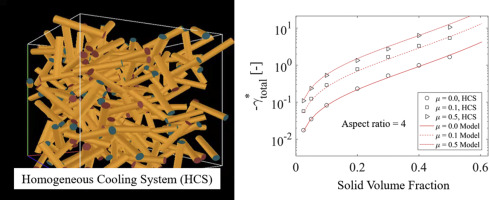当前位置:
X-MOL 学术
›
Powder Technol.
›
论文详情
Our official English website, www.x-mol.net, welcomes your
feedback! (Note: you will need to create a separate account there.)
Development of a collisional dissipation rate model for frictional cylinders
Powder Technology ( IF 4.5 ) Pub Date : 2020-04-01 , DOI: 10.1016/j.powtec.2019.01.068 Kevin E. Buettner , Yu Guo , Jennifer S. Curtis
Powder Technology ( IF 4.5 ) Pub Date : 2020-04-01 , DOI: 10.1016/j.powtec.2019.01.068 Kevin E. Buettner , Yu Guo , Jennifer S. Curtis

|
Abstract Homogeneous cooling system (HCS) and shear flow (SF) particulate systems are simulated using the discrete element method (DEM) to develop a collisional dissipation rate model for frictional cylinders. This combination of driven and undriven simulations provides a foundation of results that are not affected by particle alignment or clustering. Particle aspect ratio (AR), coefficient of restitution (e), coefficient of friction (μ), and solid volume fraction (αs) are all varied to produce a collisional dissipation rate model based on a decoupling of e and μ. The new dissipation rate model for frictional cylinders modifies the dissipation rate model for frictionless spheres, where e is replaced with an effective coefficient of restitution (eeff) that is a function of μ. Analysis of the granular temperature ratio indicates that a two-fluid model describing the flow of frictional cylinders will require a rotational granular energy balance.
中文翻译:

摩擦圆柱碰撞耗散率模型的建立
摘要 使用离散元方法 (DEM) 模拟均质冷却系统 (HCS) 和剪切流 (SF) 颗粒系统,以开发摩擦气缸的碰撞耗散率模型。这种驱动和非驱动模拟的组合提供了不受粒子对齐或聚类影响的结果基础。粒子纵横比 (AR)、恢复系数 (e)、摩擦系数 (μ) 和固体体积分数 (αs) 都发生变化,以基于 e 和 μ 的解耦产生碰撞耗散率模型。摩擦圆柱体的新耗散率模型修改了无摩擦球体的耗散率模型,其中 e 被替换为有效恢复系数 (eeff),该系数是 μ 的函数。
更新日期:2020-04-01
中文翻译:

摩擦圆柱碰撞耗散率模型的建立
摘要 使用离散元方法 (DEM) 模拟均质冷却系统 (HCS) 和剪切流 (SF) 颗粒系统,以开发摩擦气缸的碰撞耗散率模型。这种驱动和非驱动模拟的组合提供了不受粒子对齐或聚类影响的结果基础。粒子纵横比 (AR)、恢复系数 (e)、摩擦系数 (μ) 和固体体积分数 (αs) 都发生变化,以基于 e 和 μ 的解耦产生碰撞耗散率模型。摩擦圆柱体的新耗散率模型修改了无摩擦球体的耗散率模型,其中 e 被替换为有效恢复系数 (eeff),该系数是 μ 的函数。











































 京公网安备 11010802027423号
京公网安备 11010802027423号